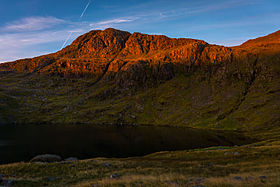Esk Pike
| Esk Pike | |
|---|---|

|
|
| Highest point | |
| Elevation | 885 m (2,904 ft) |
| Prominence | 105 m (344 ft) |
| Parent peak | Bowfell |
| Listing | Hewitt, Nuttall, Wainwright |
| Coordinates | 54°27′22″N 3°10′48″W / 54.45622°N 3.17995°WCoordinates: 54°27′22″N 3°10′48″W / 54.45622°N 3.17995°W |
| Geography | |
| Location | Cumbria, England |
| Parent range | Lake District, Southern Fells |
| OS grid | NY236074 |
| Topo map | OS Landrangers 89, 90, Explorer OL6 |
Esk Pike is a fell in the English Lake District, one of the great cirque of hills forming the head of Eskdale.
The Southern Fells include the highest ground in England, a horseshoe which begins with Scafell and Scafell Pike in the west and then curves around the north of Upper Eskdale to take in Great End, Esk Pike, Bow Fell and Crinkle Crags. As the name suggests, Esk Pike stands at the head of the valley, although it is not the highest of these fells.
To the north-west of Esk Pike is the depression of Esk Hause, a broad saddle carrying a number of important paths. The ‘true’ Esk Hause—so named by Alfred Wainwright in his influential Pictorial Guide to the Lakeland Fells—is the north–south route from Borrowdale to Eskdale. A lower path—the ‘false’ Hause—runs east–west from Langdale to Wasdale, passing a stone windshelter. There are also paths climbing to the summits of Esk Pike and Allen Crags, together with the popular Calf Cove route to Scafell Pike, all contributing to make Esk Hause a confusing place in mist. The source of the main branch of the Esk flows south from the Hause, while to the north the topography is more complex. Allen Crags stands adrift from the main ridge, with the valleys of Langstrath and Grains Gill falling on either side. These combine some miles downstream to form the River Derwent, flowing through Borrowdale to Derwentwater and Keswick.
South-east of the summit of Esk Pike is Ore Gap, the col separating it from Bow Fell. The soil here is red due to haematite, and climbing lore suggests that magnetic compasses cannot be trusted in this locality. North of the gap is Angle Tarn, a feeder of the Langstrath. This round tarn occupies a corrie beneath Hanging Knotts, small trout lurking in its 50-foot depths.
...
Wikipedia

